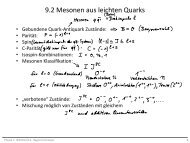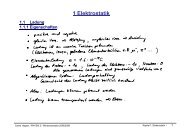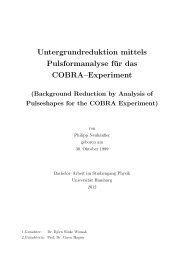Setup of a Drift Tube Muon Tracker and Calibration of Muon ...
Setup of a Drift Tube Muon Tracker and Calibration of Muon ...
Setup of a Drift Tube Muon Tracker and Calibration of Muon ...
Create successful ePaper yourself
Turn your PDF publications into a flip-book with our unique Google optimized e-Paper software.
Chapter 4The Borexino ExperimentThe Borexino Experiment was designed for the real time spectroscopic detection <strong>of</strong>solar neutrinos. Its main goal is the measurement <strong>of</strong> 7 Be neutrino flux, but also8 B, pep <strong>and</strong> CNO solar neutrinos belong to the scientific program. Apart fromsolar neutrinos, also geo-neutrinos have been observed recently. The detector islocated underneath approximately 1400 m <strong>of</strong> rock overburden (≈ 3800 m.w.e. 1 ) inthe LNGS underground laboratory in Italy. The detection <strong>of</strong> neutrinos is done usingliquid scintillator <strong>and</strong> the experiment is surrounded by ultra pure water acting as aČerenkov muon veto. Detecting low energetic neutrinos at low rates requires a highradio purity <strong>of</strong> all materials involved—especially the scintillator—which has beenachieved for Borexino. This chapter gives an overview <strong>of</strong> the detection methods <strong>of</strong>neutrinos in liquid scintillators, especially in Borexino. A description <strong>of</strong> the detectordesign is then given. It is followed by a discussion <strong>of</strong> background sources. Specialcare is given to the cosmogenic background in the scintillator <strong>and</strong> how it can beaccounted for. In the last section <strong>of</strong> this chapter the results so far obtained byBorexino are presented.4.1 Neutrino Detection in BorexinoBorexino uses liquid scintillator for the detection <strong>of</strong> low energetic neutrinos. Thescintillator acts as both target <strong>and</strong> detection material. Neutrinos react with thescintillator through different processes. Neutrinos—electron type neutrinos ν e inparticular—can be detected through elastic scattering whereas anti-electron-neutrinoscan be detected via the inverse β decay. During both processes, energy is depositedin the scintillator which can be detected by the scintillation light. Both processesare described in detail below.4.1.1 Elastic Scattering in Liquid ScintillatorThe elastic scattering <strong>of</strong> neutrinos on electrons in the scintillator is the dominantprocess for the detection <strong>of</strong> solar neutrinos. The scattering process1 m.w.e. meter water equivalentν e + e − → ν e + e − (4.1)51





